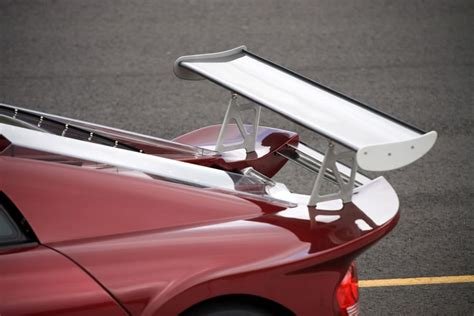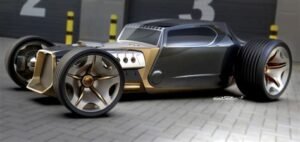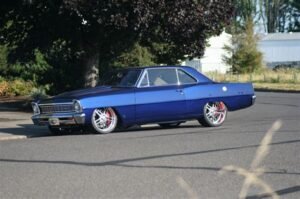
With great sunny weather, California embodies a true classic car paradise that offers energetic car culture, which warmly embraced both classic and modern vehicles. However, classic car modification is not that easy in the Golden State because the state has a number of strict vehicle modification laws. The following overview looks at the world of classic car modification in California with respect to both the law and styling that sets these cars apart. From an overview of the basic rules and regulations of California, the topics will range to ways you can achieve a unique look while staying within the boundaries of the law.
Understanding California’s Vehicle Modification Laws
California is well notorious for its very strict and specific vehicle modification laws necessary for reasons of safety and concerns about the environment. Some of the special classic car modifications under the California Vehicle Code include but are not limited to:
1. Safety Above All: Bumper Height and Lighting
Safety above all in California means that all modified vehicles should not compromise safety features that were installed originally to safeguard occupants. This therefore calls for adherence to a set of specified requirements concerning bumper height and lighting, as will be explained below.
Bumper Height
Minimum bumper heights are required in California to offer adequate protection in a collision. The front bumpers must be at least 15 inches off the ground while the rear bumpers remain at a minimum of 16 inches high. An exception to this is for those vehicles manufactured before 1972, for which the bumpers can be lower than the number mentioned above. Please do make sure you check the information for your classic car.
Lights
Headlights, taillights, and turn signals must be altered according to the specifications set by the State of California. Changes that affect the light’s pattern or visibility can create potential legal issues. Modifications to be done must strictly adhere to specifications and brightness that are approved by the authority. And also involves installation of third-party lights.
2. Mufflers: Noise Restrictions
California is renowned for having the most stringent noise pollution laws. As a result, the tuning of the exhaust system must be given particular thought to avoid surpassing the legal limit on sound levels. Depending upon the kind of vehicle and the year in which it was manufactured, CVC has specified limits on the amount of noise a vehicle can generate.
Noise Limits in California
This test gauges noise levels from a required distance as the vehicle drives past. Limits related to this test are dependent on type of vehicle and year of manufacture. Classic automobile limits may be higher than those manufactured within the more recent past.
Idle Test:
This test measures the noise level while the vehicle is in idle. Limits are generally lower than pass-by limits and once again are dependent on type of vehicle and year.
These limits are easily exceeded when performance or cosmetic modifications are made to exhaust systems. If you’re looking to modify your exhaust system, you might want to check with a local, reputable shop that deals with classic car modifications to ensure that yours meets the legal limits. After all, getting caught with a noisemaker can result in fines and, in some cases, even vehicle impoundment.
3. Emissions: Staying Green
California was one of the first states to enact strict environmental legislation. For this reason, any modification that affects a vehicle’s emissions system is carefully controlled.
Maintaining Emissions Compliance
Smog check requirements based on vehicle’s year of manufacture must be satisfied. Owners of classic cars must ensure that the following modifications do not fall below emissions standards : catalytic converter, exhaust manifold, and engine management systems.
Smog Check Requirements
Modifying the emission system in your classic car can easily alter the set of requirements that it has to meet during a smog check. The smog check program within the state ensures that vehicles meet minimum standards within emission. Modification done to the vehicle, which changes or alters the emission system, can lead to a failure in the smog check and hence render it illegal to drive on the road.
4. Tire and Wheel Modification: Balancing Style with Safety
Changing the tires and wheels of a classic car greatly enhances its looks, but safety should in no way be compromised.
Tire Size vs. Width
California law does allow for tire size and width changes, but with some limits. These limits ensure that your vehicle will handle and stop correctly. Check your vehicle’s owner’s manual for recommended tire sizes. You can also check the California DMV website for regulations on this topic.
Tire Size and Wheel Offset
Such changes in the size of the wheels and their offset must be made with utmost care to avoid safety hazards. Wheel size refers to its diameter, while the wheel offset describes the relation of the wheel center relative to the hub. The wrong offset can afford improper wheel clearance that may rub and provide suspension complications.
Wheel and Tire Combinations
Changes to wheels and tires must be done first and foremost with safety in mind. This includes keeping tires and wheels appropriately sized and within California’s minimum safety requirements. A vehicle cannot be modified in a manner that would adversely affect wheel clearance can alter steering angles or deviate from how a vehicle was designed and intended to handle on the road.
5. Registration and Inspection: Keeping Your Classic Legal
Proper registration and inspection of your modified classic car help it retain its legal status on the roads of California.
Title and Registration Requirements
Equally important, after the modifications, is that the title and registration of your car should show evidence of the change. This may be the registering of the car as modified. The requirements and procedures followed are usually from the DMV.
Inspection Requirements
The California Highway Patrol may inspect a modified vehicle at any time to ensure it conforms to the set regulations. Any form of modification that may have an impact on vehicle safety or performance is subject to inspection. Be sure to familiarize yourself with the specific regulations that apply to your classic car model year and type of modification.
Classic Car Modifications in California: Legal Considerations
While California is very friendly to classic car enthusiasts, it has a number of rules and regulations that must be handled with care. Here are some of the most important legal considerations.
1. Research and Compliance
First things first, any modification should be highly researched so it will comply with California’s regulations. Take time to know what CVC says about the modification at hand and consult with experts like automotive experts or mechanics if it confirms your modification is legal.
2. Safety First
Safety First in the Modification of Classic Cars
Never make any modification to your classic car that will affect its stability, braking, or lighting. Remember, safety is paramount, and it’s reflected in the Californian regulations.
3. Proper Documentation
Keep detailed records of modifications done, including parts used and dates of installation. This documentation will be useful during any inspection or registration processes to prove the legality of modifications done.
4. Inspections and Registration
When you have made your modifications, you will be taking your classic car in for inspections and registering it. Modifications may be subject to inspections at the discretion of the CHP, and in order to operate your vehicle on the roads legally in California, your vehicle needs to be registered.
5. Consulting Experts
Never be afraid to seek advice from professionals, whether mechanics, automotive professionals, or even the DMV, regarding specific changes you are contemplating. Their expertise might save you from legal problems and make sure that your modifications are both stylish and compliant.
Conclusion
Modifying a classic car can be truly rewarding in California, but there are some very specific details one must address regarding California’s unique regulations. You will have a truly remarkable classic if you make sure safety comes first, take the time to understand the various legal requirements involved in classic car modification, and receive advice from several experts. More importantly, a well-cared-for and legally modified classic car speaks much about its timeless beauty and your devotion to the road.




